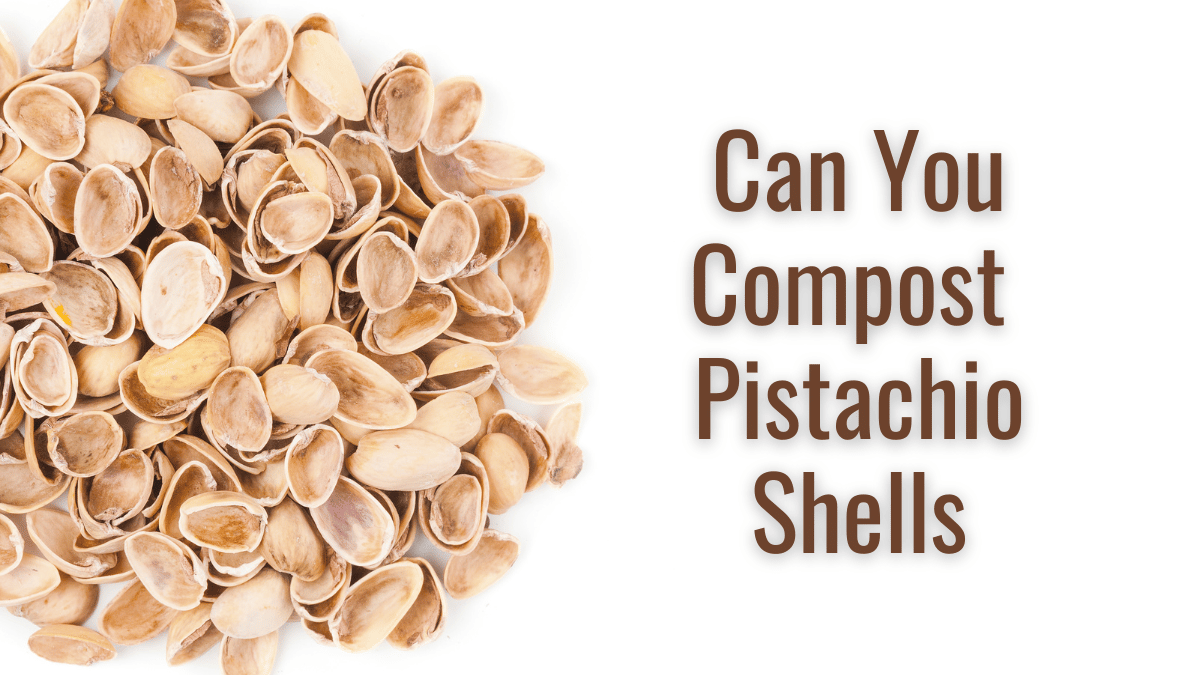We use affiliate links to run our site. When you buy through links on our site, we may earn an affiliate commission, without any added cost to you. Learn more
Composting is like magic for our gardens, transforming kitchen scraps into nutrient-rich gold for our plants. But with pistachio shells, things can get a little tricky. Some folks say, “Yes, go ahead and toss them in,” while others have their reservations.
So, let’s explore the ins and outs of composting with pistachio shells. We’ll keep it simple and down-to-earth, just like our approach to organic gardening.
What are Pistachio Shells Made Of?
Pistachio shells consist of cellulose and lignin, natural polymers found in plant cell walls, giving them strength and rigidity to protect the nut inside.
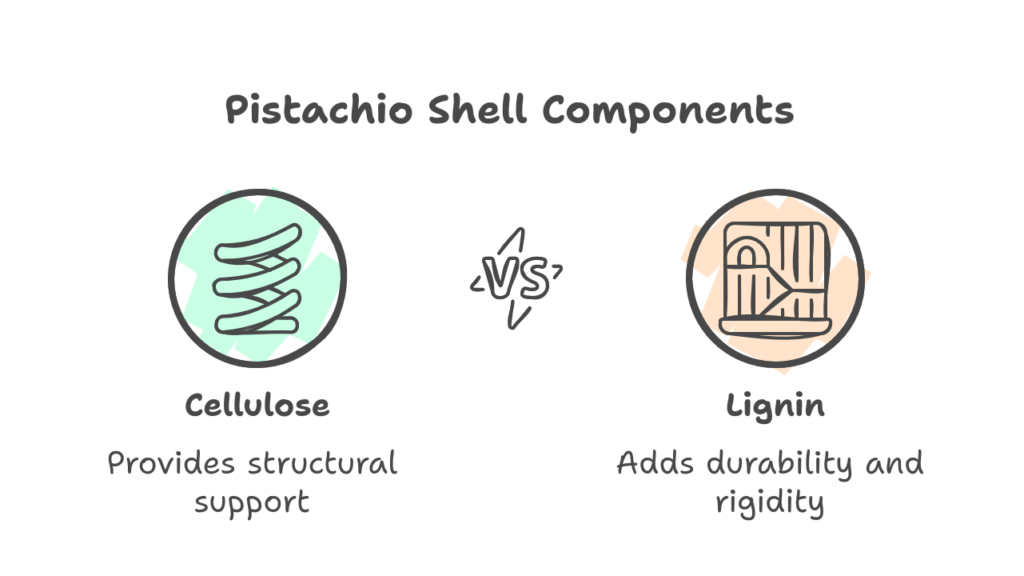
As drupes, pistachio shells are exceptionally hard, safeguarding the seed from damage or being eaten by animals before germination.
Cellulose provides structural support, like in plants, while lignin adds durability, creating a strong and resilient shell.
This natural combination ensures pistachios can endure tough conditions while protecting the delicate kernel within, striking a perfect balance between flexibility and rigidity.
Concerns with Composting Pistachio Shells
When composting pistachio shells, there are three main concerns to address:
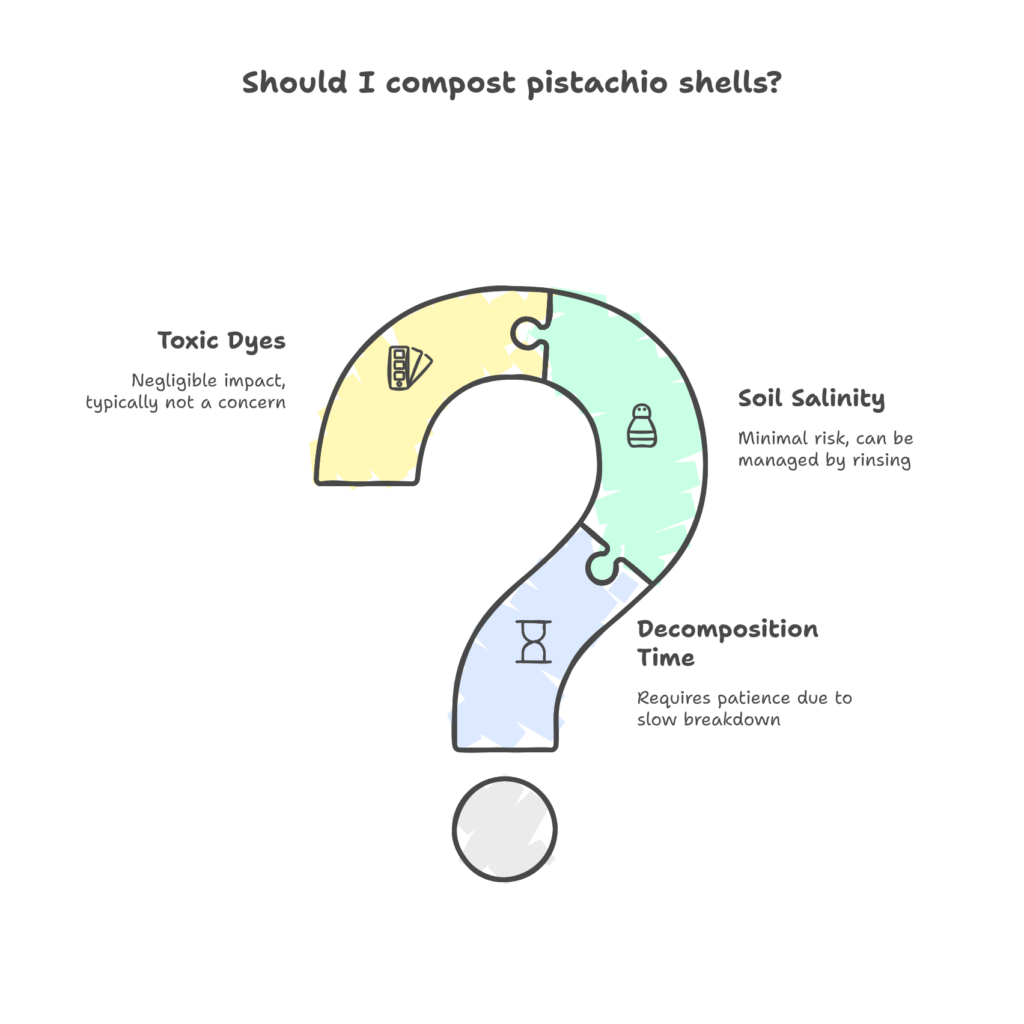
- Decomposition Time: While pistachio shells will eventually break down, they do so at a slow pace. Composting nutshells, including pistachio shells, requires patience as they take a considerable amount of time to fully decompose.
- Soil Salinity: Some worry that the salt content in pistachio shells may disrupt the balance of soil salinity. However, for the average composting enthusiast, the amount of pistachio shells used is unlikely to cause significant salt-related issues. A simple rinse of the shells before composting can also help control the salt content.
- Toxic Dyes: While there are dyed pistachio shells, the amount used in compost is typically negligible and shouldn’t have a notable impact on the compost’s quality.
Considering these factors, composting pistachio shells might not yield significant benefits due to their slow decomposition rate and limited contributions to the compost’s nutritional value.
As a result, some may choose to avoid composting overly processed shells for the sake of efficiency and effectiveness.
How Long Do Pistachio Shells Take to Decompose?
The decomposition process of pistachio shells is relatively slow compared to other popular composting ingredients. In a compost pile where conditions are more conducive for decomposition, it can take 2-3 years for them to biodegrade completely. In natural outdoor environments, they might take even longer than 3 years to break down fully.
I prefer to grind up the shells before adding them to the compost pile. They will still take time to break down, but they add a nice bulk to your compost.
Comparison with Other Compostable Materials:
Here is a table showing the decomposition speeds (the time it takes to decompose fully) for different composting ingredients:
| Composting Ingredient | Decomposition Speed (Time to Decompose Fully) |
|---|---|
| Fruit and Vegetable Scraps | 2-4 weeks |
| Coffee Grounds | 2-5 weeks |
| Eggshells | 6 months |
| Lawn Clippings | 1-3 months |
| Leaves | 3-6 months |
| Cardboard | 2 months |
| Paper | 2-5 months |
| Sawdust | 6 months – 1 year |
| Wood Chips | 6 months – 1 year |
| Pistachio Shells | 2-3 years |
| Cotton and Wool Fabric | 6 months – 2 years |
| Fruit Pits (e.g., peach pits) | 1 year |
| Corn Cobs | 1-2 years |
| Nut Shells (excluding pistachio) | 1-3 years |
| Straw | 1-3 years |
| Twigs and Branches | 1-3 years |
| Pine Needles | 2-3 years |
| Pine Cones | 3-4 years |
| Paper Towels | 2-4 weeks |
| Tea Bags | 1-3 months |
How to Compost Pistachio Shells at Home
To properly compost pistachio shells, follow these steps:
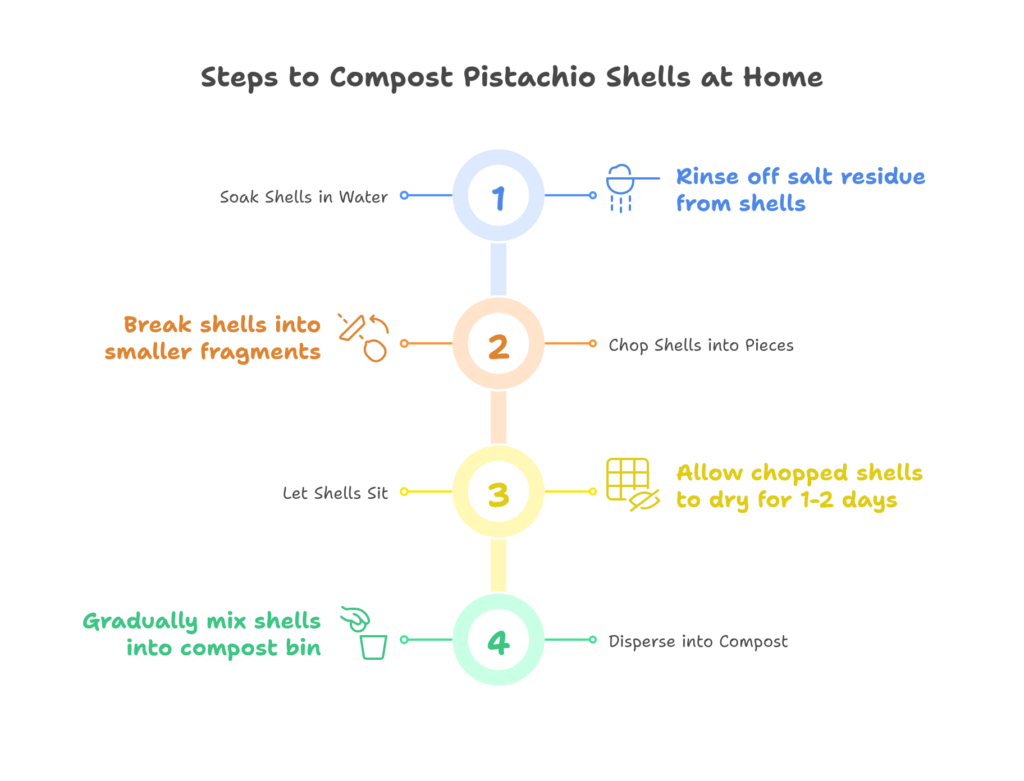
- First, soak the pistachio shells in water. This will remove any salt residue, This is essential if your pistachios are salted.
- After a few hours, remove the shells from the water and set them aside.
- Now, chop the shells into smaller pieces. Doing this simple step will speed up the decomposition process.
- Let the chopped shells sit for one to two days.
- Finally, slowly disperse the shells into your compost, sprinkling them in and rotating the compost bin regularly to prevent an imbalance.
Are Pistachio Shells Biodegradable?
Absolutely! Pistachio shells are indeed biodegradable, meaning they can naturally break down with the help of microbes.
Unlike materials that persist in landfills for decades or even centuries, pistachio shells take a relatively short period of around 3 years to biodegrade.
When it comes to sustainable gardening, every little bit counts. Pistachio shells might take their sweet time to break down, but crush them up and you’ll find they add wonderful structure and aeration to your compost heap. Patience is the gardener’s best friend-those shells will eventually reward you with richer, healthier soil.
Now, let’s talk about composting.
Since pistachio shells are biodegradable, they do qualify as composting ingredients. However, to be a good ingredient, a biodegradable material must ultimately contribute to nutrient-rich compost. Luckily, pistachio shells fit the bill perfectly and can make a wonderful addition to any compost pile.
To make a good quality compost, you need a proper C/N ratio or Carbon Nitrogen ratio. ‘Brown’ ingredients encompass materials like dried leaves and twigs, while ‘green’ includes food scraps and freshly cut grass. Pistachio shells fall into the ‘brown’ category, as they are rich in carbon.
Pistachio shells, along with other nutshells, also serve another purpose in the compost pile. They improve aeration by creating gaps that allow air to circulate. Adequate aeration is vital for the microbes to thrive and ensure the composting process remains active and odor-free.
Other Uses of Pistachio Shells
There are many ways you can use Pistachio shells other than making compost. Here are some examples:
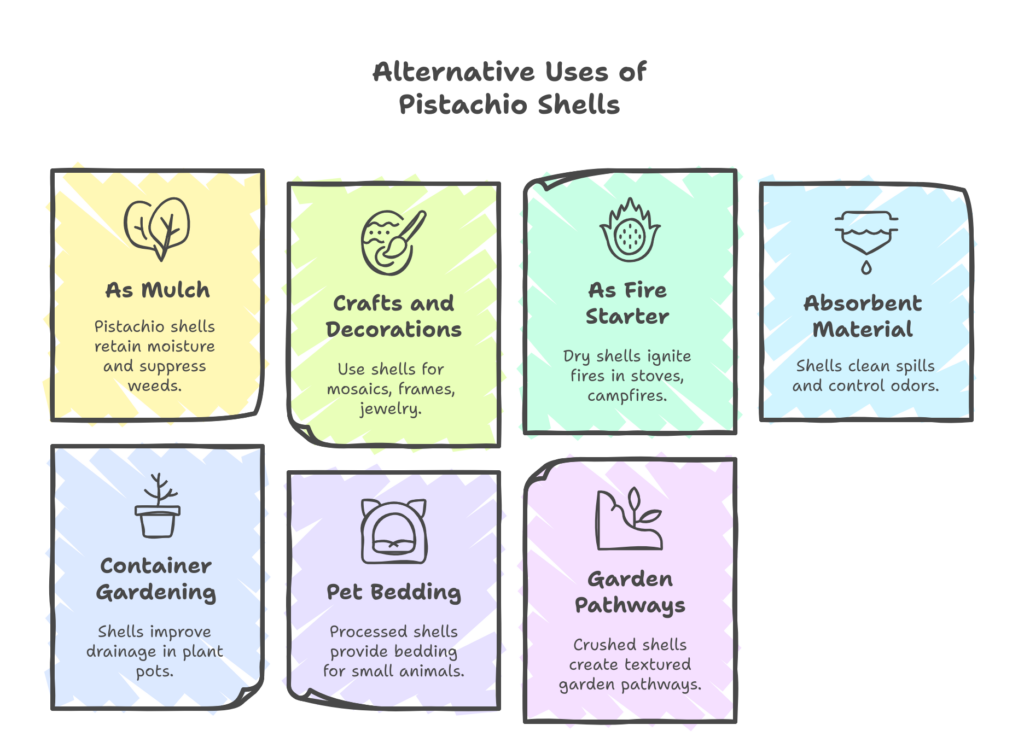
As Mulch: Crushed pistachio shells can serve as a natural and attractive mulch for garden beds, helping to retain moisture and suppress weed growth.
In Crafts and Decorations: If you are an artist and crafter, you can use pistachio shells for creating unique and eco-friendly craft items like mosaics, picture frames, jewelry, or decorative pieces.
As A Fire Starter: Dry pistachio shells can be used as a natural fire starter for fireplaces, wood-burning stoves, or campfires due to their flammable properties.
As Absorbent Material: Crushed pistachio shells can be used as an absorbent material for cleaning up spills and controlling odors in certain applications.
Increase Drainage in Container Gardening: In gardening, pistachio shells can be used at the bottom of plant pots to improve drainage, preventing waterlogged soil.
Pet Bedding: The shells can be processed and used as bedding for small animals like hamsters, guinea pigs, or birds, providing a comfortable and biodegradable option.
Garden Pathways: Crushed pistachio shells mixed with other materials can create a textured and visually appealing surface for garden pathways.
A Mini Story :
Sarah, an avid home gardener in Portland, Oregon, faced a persistent issue: her raised vegetable beds were always waterlogged after heavy rain. The clay-rich soil in her garden retained too much moisture, leading to stunted root growth and yellowing leaves on her tomatoes and peppers. Traditional solutions like adding sand or gravel were either ineffective or too costly for her small-scale setup.
After reading about sustainable gardening hacks, Sarah decided to repurpose pistachio shells from her family’s snack habit. She rinsed and crushed the shells, then mixed them into the top 6 inches of her raised beds along with compost. The hard shells created air pockets, improving soil aeration and drainage without introducing chemicals or expensive materials.
Within a few weeks, Sarah noticed a dramatic improvement. The beds drained efficiently after rain, and her vegetables developed stronger roots and greener foliage. The pistachio shells also deterred slugs and snails, reducing pest damage. By the end of the season, Sarah’s harvest was her best yet-and she’d found an eco-friendly way to solve her drainage dilemma while reducing kitchen waste.
Key Takeaways:
Pistachio shells, often discarded as trash, can be a game-changer for gardeners facing drainage issues. By turning waste into a resource, Sarah not only solved her problem but also made her gardening more sustainable.
Final Thoughts:
While pistachio shells are a natural material and may eventually break down in a compost pile, they do need additional time and effort to fully decompose. As they are high in lignin, they break down quite slowly compared to other compostable materials.
Having said that, you can include pistachio shells in the compost mix. Just make sure to crush or grind the shells before adding them to speed up the decomposition process.
I hope you like the information we shared in this post. You can find more interesting articles about composting here. Feel free to share this post with others.
Frequently Asked Questions (FAQs):
Can I use pistachio shells directly as mulch without composting?
Yes, crushed pistachio shells can be used as a mulching material directly without composting. They provide added benefits to the soil, including improved water retention and weed suppression.
Are there any safety precautions when using pistachio shells in compost?
While pistachio shells are generally safe for composting, it’s crucial to avoid shells from salted or flavored pistachios, as the added salts and seasonings may harm the composting process and affect the soil quality.
Can I compost pistachio shells with other nutshells?
Yes, you can compost pistachio shells alongside other nutshells like almond and walnut shells. Make sure to break them into smaller pieces to facilitate quicker decomposition.
Is compost made from pistachio shells beneficial for all plants?
Yes, compost made from pistachio shells is beneficial for most plants, as it provides essential nutrients and improves soil structure. However, some plants may require specific soil conditions, so it’s essential to research the needs of your plants beforehand.
Can I compost pistachio shells in a worm bin?
While pistachio shells can be composted in a worm bin, they are slow to decompose compared to other compostable materials. To ensure faster decomposition, crush the shells and mix them with other compostable materials.
Amazon and the Amazon logo are trademarks of Amazon.com, Inc, or its affiliates.

Hi there! My name is Prasenjit and I’m an avid gardener and someone who has grown a passion for growing plants. From my hands-on experience, I have learned what works and what doesn’t. Here I share everything I have learned.
